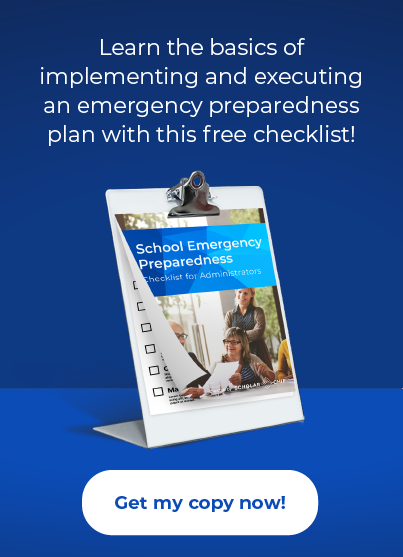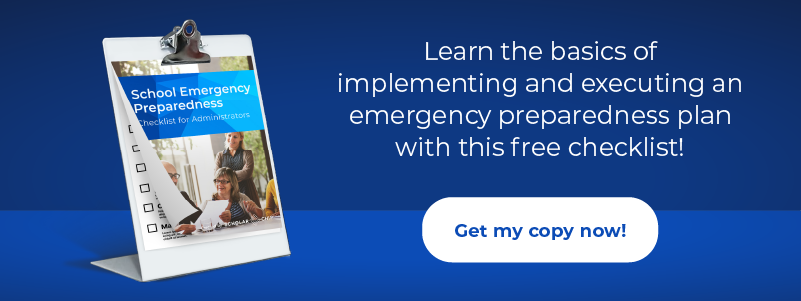Up-to-date school emergency operations plans (EOPs) are essential for the safe functioning of your campus. While you likely have an effective plan in place, have you considered how often you should be updating that plan? For instance, Ohio schools need to submit re-evaluations of their emergency plans to the Ohio Department of Education every three years. Most schools have similar timelines.
So, if you’re deciding whether your school emergency response procedures need to be modernized, there are four major factors to keep in mind: remodels or additions to your campus buildings, new or previously-unidentified hazards, the needs of the entire campus community, and new advances in school safety technology. Let’s discuss key questions that you should ask in order to determine if your school emergency response procedures might need a revision.
Have you examined the safety and security of all your campus buildings?
FEMA recommends a site assessment to consider the “safety, accessibility, and emergency preparedness” of every building. If you have any buildings on your grounds that you failed to assess in preparing your last EOP, you should now evaluate their potential risks.
Factors you should consider include:
- The building’s structure
- The building’s accessibility and compliance with standards for people with disabilities
- The building’s ease in access for emergency vehicles
- The access of pathways to enter and exit the building
In addition to this assessment, you also want to make sure there are sufficient personnel and resources for this building in an emergency event. For instance, is the building stocked with enough supplies?
Are there hazards that are newly identified (i.e., COVID-19) or that you missed in your previous EOP?
An EOP needs a revision if there is a new hazard that needs to be accounted for in your area. These could be new risks of natural disasters, such as earthquakes in Oklahoma.
The most problematic new threat is COVID-19, which must be accounted for in your EOP. Even if your plan already includes considerations for other viruses, the ease with which COVID-19 is spread warrants a reconsideration.
Have you considered the needs of your entire campus community, including students with disabilities, students living in poverty, and other overlooked demographics?
If you’ve overlooked a demographic of students in your EOP, it’s time to make your plan fully comprehensive. For instance, you may need to consider how to evacuate students with cognitive disabilities in an emergency event.
COVID-19 emergency plans should also reflect the diversity of your campus. For instance, if you need to have a quick dismissal due to an identified case, where will students whose parents can’t immediately leave work stay in the meantime? If part of your emergency plan includes long-term dismissals and online learning, how will you help students with learning disabilities stay on track?
Are there new technologies that didn’t exist or were overlooked in your previous EOP?
It’s important to consistently reevaluate if new technology or procedures could improve your emergency response procedures. “A brief sample of basic school security measures include cost-free and lower cost measures such as, but not limited to, reducing the number of open doors, having functional communications systems, keeping trees and shrubs trimmed to promote natural visibility, and establishing procedures for accurately and timely reporting of school crimes,” writes Ken Trump in his School Security Blog.
Security methods offered by ScholarChip include the following:
- The One Card. School officials need to be able to monitor students’ whereabouts at school at all times. To do this, students should carry One Cards, unique ID monitoring devices that they use as identity markers at all times. Knowing where students are ensures that you can quickly and efficiently evacuate the campus.
- Secure Door Access. As mentioned, a vital factor in improving campus security is reducing the number of open doors. Secure Door Access readers from ScholarChip keep doors locked unless students, faculty, and staff are supposed to enter. For instance, if a student needs to enter a classroom at a certain time, they can open the door using their card. If they are not supposed to be in that classroom, their card will not open the door.
- Visitor Access Management. This product tracks the criminal history of visitors who may want to enter your campus. It prints badges for every visitor who has been authorized so you can monitor their access. The technology also lets you know when a visitor leaves campus, so you no longer have to track them.
Regularly revisiting your school emergency response procedures is a critical component of keeping your campus safe. As times change, threats to your campus safety—like a COVID-19 outbreak—will require constant monitoring of your plan. Furthermore, as technology becomes more advanced, you will want to keep revisions at the top of the priority list. Only with regular adaptations can you keep your entire campus community safe.
ScholarChip offers holistic school safety services aligned with CDC guidelines to help schools reopen amidst growing health concerns. Through our advanced technology, built and designed for the K-12 environment, schools can identify risks and mitigate the spread of infection. Our solutions include fever screening, visitor surveys, symptom and vaccine tracking, in-school contact tracing, alerts and notifications. Learn more about our advanced COVID-19 solutions or request a reopening strategy session today!


